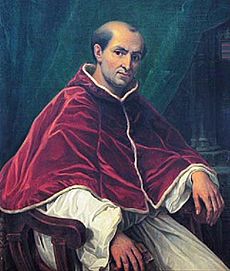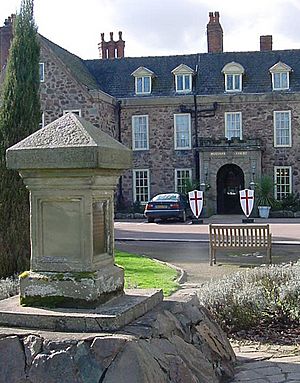Rothley Temple facts for kids

The Templar Chapel built c.1240; incorporated into a later building
|
|
| Monastery information | |
|---|---|
| Other names | Rothley Temple |
| Order | Knights Templar From 1313: Knights Hospitaller |
| Established | c.1231 |
| Disestablished | 1540 |
| Mother house | from c.1371: Dalby Preceptory |
| Site | |
| Location | Rothley, Leicestershire |
| Coordinates | 52°42′20″N 1°08′52″W / 52.7056°N 1.1478°W |
| Visible remains | The Preceptory's chapel and part of the domestic buildings still remain as part of the Rothley Court Hotel. |
Rothley Preceptory (pronounced Rowth-Ley) was a special kind of religious building in Rothley, Leicestershire, England. It was like a base for groups of knight-monks called the Knights Templar and later the Knights Hospitaller.
Today, the old chapel of the preceptory is part of the Rothley Court Hotel.
Contents
History of Rothley Preceptory
How Rothley Preceptory Started
Rothley Preceptory was set up around the year 1231. However, the Knights Templar already owned land in Rothley much earlier. This was during the time of King John (1199–1216).
When the preceptory was officially started, King Henry III gave the Knights Templar the manor and church in Rothley. The preceptory eventually owned land in 13 nearby villages. They also had farms called granges at Baggrave and Gaddesby. The knights also owned the main house at Gaddesby.
Around 1250, the preceptory made about £62 each year. This money helped other Knights Templar who were in Acre, a city in what is now Israel.
In 1284, King Edward I gave the knights permission to hold a weekly market in Rothley. This market was held every Monday. They could also have a yearly fair in June, celebrating Saint Barnabas.
Later, in 1306, King Edward changed this. He allowed the knights to hold their market and fair at their manor in Gaddesby instead. The Gaddesby market was held on Wednesdays. The yearly festival there was in July, honoring Mary Magdalen.
The End of the Knights Templar
After losing the Holy Land in 1291, the Knights Templar became less powerful. Their main base moved to France. Soon after, King Philip IV of France started to work against them. He owed a lot of money to the Templars.
King Philip used his influence over Pope Clement V. The Pope then ordered the arrest of the Templars. They were accused of many serious things. Many knights confessed after being forced.
With these confessions, and after more pressure from the French King, Pope Clement issued an order. This order, called the Pastoralis Praeeminentiae, came out on November 22, 1307. It told all kings in Europe to arrest the Knights Templar. It also said to take all their property for the church. This way, King Philip no longer owed them money.
At first, King Edward II of England did not believe the accusations. But in 1308, Rothley Preceptory was taken by the Crown. All other Templar properties in England were also seized.
An official list from 1309 shows what the preceptory had. It included a hall and a chapel, built around 1240. They also had more than 350 sheep.
The Knights Hospitaller Take Over
In 1313, Rothley Preceptory and its lands were given to another group. This group was called the Military Hospitaller Order of St John of Jerusalem. They are better known as the Knights Hospitaller.
Rothley was not run as a separate preceptory by the Hospitallers. By 1371, it was joined with the Dalby and Heather Preceptory. This was another Hospitaller base in Leicestershire. One leader, called a Preceptor, then managed all three places from Dalby.
Around 1500, the land at Dalby, Heather, and Rothley was rented out. In 1535, the three combined preceptories made a good income. They brought in about £231 each year for the order.
In the 1400s, the Hospitallers made changes to the chapel at Rothley.
The Preceptory is Closed Down
The preceptory was officially closed down in 1540. The ownership of the Rothley Manor, which the preceptory had held, then went to the Babington family. They owned it from 1565 until 1845.
The Babingtons decided not to knock down the preceptory's chapel. Instead, they built their new house around it. Some parts of the old living quarters were also included in their new home.
Later History of Rothley Temple
Fighting to End Slavery
Rothley Temple later belonged to Thomas Babington (1758–1837). He was an important person in the Clapham Sect. This group worked hard to end the slave trade.
Thomas Babington was a close friend of William Wilberforce. They often met at Rothley Temple to write their anti-slavery bill. Babington later became a Member of Parliament for Leicester. He was also a High Sheriff of Leicestershire. He was buried in the chapel at Rothley Temple.
Today, a large stone monument stands outside the building. It has a plaque that remembers the building's role in ending slavery. It also honors Thomas Babington.
In 1800, the historian Thomas Babington Macaulay (1800–1859) was born at Rothley Temple. He was named after his uncle, Thomas Babington.
Rothley Court Hotel Today
The preceptory's chapel and some parts of the old buildings still exist. They are now part of the Rothley Court Hotel. Rothley Court was once a grand home. It includes parts of the preceptory that were changed into a house in the 1500s.
Most of what you see today comes from big renovations. These were done by John Ely of Manchester between 1894 and 1895.
The chapel was greatly repaired in 1896. In 1951, Rothley Court and the chapel were given special protection. They are now Grade I Listed Buildings. This means they are very important historical sites.
Over the years, old stone pieces and grave slabs have been found around the chapel. You can see them there today. One important discovery was a statue of a Templar knight. It was found in Rothley Churchyard in 1790. After being repaired in 2011, this statue is now inside the chapel at Rothley Temple.
Rothley Temple is also the name of a lodge for Freemasons. This group started in 1961/62. They chose the name because of the preceptory's connection to the Knights Templar.
Preceptors of Rothley
A Preceptor was the leader of a preceptory. They were like the head of an abbey or a priory. The Preceptor was in charge of the preceptory's church and land. They also managed the knight-monks who lived there. The Preceptor reported to the Grand Master of their order.
Here are some of the Preceptors when it was run by the Knights Templar:
- Stephen of Todmershe
- John Feversham
- Walter of Ewenightewith
- William of Wald
- Alexander Blundus
- William of Colewell (around 1271)
Here are some of the Preceptors when it was run by the Knights Hospitallers: (From about 1371, Rothley was managed by the Preceptor of Dalby Preceptory.)
- John Dingley (around 1371)
- John Langstrothyr (around 1448)
- Thomas Newport (died 1522)
- Henry Babbington (around 1525)
- John Babbington (died 1534)
- Sir Henry Poole (1535/6 – 1540)
See also




